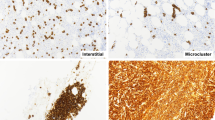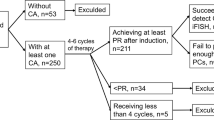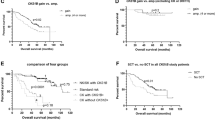Abstract
Recent studies have shown that two recurrent translocations, t(4;14)(p16;q32) and t(11;14)(q13;q32), define distinct entities with different prognosis in multiple myeloma (MM). We addressed the issue of whether these illegitimate IGH rearrangements could contribute to the morphological heterogeneity of the malignant plasma cells (PC). Bone marrow aspirates of 178 untreated MM cases with successful molecular cytogenetics analysis using fluorescence in situ hybridization were reviewed. PC of 25/48 (52%) patients with t(11;14) exhibited a lymphoplasmacytoid morphology. Moreover, 25/27 (93%) of the cases with this morphological profile bore the t(11;14). In addition, both cytogenetics and morphological subtypes shared higher incidence of nonsecretory MM. In contrast, 17 out of 28 cases (61%) with t(4;14) exhibited PC with diffuse chromatin pattern. Interestingly, both t(4;14) translocation and immature morphology correlated with higher incidence of high tumor mass and chromosome 13 abnormality. In conclusion, our results suggest that a particular morphology can be the signature of chromosomal abnormalities in MM.
This is a preview of subscription content, access via your institution
Access options
Subscribe to this journal
Receive 12 print issues and online access
$259.00 per year
only $21.58 per issue
Buy this article
- Purchase on Springer Link
- Instant access to full article PDF
Prices may be subject to local taxes which are calculated during checkout


Similar content being viewed by others
References
Greipp PR, Raymond NM, Kyle RA, O'Fallon WM . Multiple myeloma: significance of plasmablastic subtype in morphological classification. Blood 1985; 65: 305–310.
Carter A, Hocherman I, Linn S, Cohen Y, Tatarsky I . Prognostic significance of plasma cell morphology in multiple myeloma. Cancer 1987; 60: 1060–1065.
Goasguen JE, Zandecki M, Mathiot C, Scheiff JM, Bizet M, Ly-Sunnaram B et al. Mature plasma cells as indicator of better prognosis in multiple myeloma. New methodology for the assessment of plasma cell morphology. Leukemia Res 1999; 23: 1133–1140.
Greipp PR, Leong T, Bennett JM, Gaillard JP, Klein B, Stewart JA et al. Plasmablastic morphology – an independent prognostic factor with clinical and laboratory correlates: Eastern Cooperative Oncology Group (ECOG) myeloma trial E9486 report by ECOG myeloma laboratory group. Blood 1998; 91: 2501–2507.
Moreau P, Facon T, Leleu X, Morineau N, Huyghe P, Harousseau JL et al. Recurrent 14q32 translocations determine the prognosis of multiple myeloma, especially in patients receiving intensive chemotherapy. Blood 2002; 100: 1579–1583.
Fonseca R, Blood EA, Oken MM, Kyle RA, Dewald GW, Bailey RJ et al. Clinical and biologic implications of recurrent genomic aberrations in myeloma. Blood 2003; 101: 4569–4575.
Avet-Loiseau H, Facon T, Grosbois B, Magrangeas F, Rapp MJ, Harousseau JL et al. Oncogenesis of multiple myeloma: 14q32 and 13q chromosomal abnormalities are not randomly distributed, but correlate with natural history, immunological features and clinical presentation. Blood 2002; 99: 2185–2191.
Hoyer JD, Hanson CA, Fonseca R, Greipp PR, Dewald GW, Kurtin PJ . The t(11;14)(q13;q32) translocation in multiple myeloma. A morphologic and immunohistochemical study. Am J Clin Pathol 2000; 113: 831–837.
Fonseca R, Blood E, Rue M, Harrington D, Oken MM, Kyle RA et al. Myeloma and the t(11;14)(q13;q32); evidence for a biologically defined unique subset of patients. Blood 2002; 99: 3735–3741.
Robillard N, Avet-Loiseau H, Garand R, Moreau P, Pineau D, Rapp MJ et al. CD20 is associated with a small mature plasma-cell morphology and t(11;14) in multiple myeloma. Blood. Prepublished April 17, 2003; doi:10.1182/blood-2002-11-3333.
Avet-Loiseau H, Garand R, Lodé L, Harousseau JL, Bataille R . Translocation t(11;14)(q13;q32) is the hallmark of IgM, IgE and nonsecretory multiple myeloma variants. Blood 2003; 101: 1570–1571.
Author information
Authors and Affiliations
Rights and permissions
About this article
Cite this article
Garand, R., Avet-Loiseau, H., Accard, F. et al. t(11;14) and t(4;14) translocations correlated with mature lymphoplasmacytoid and immature morphology, respectively, in multiple myeloma. Leukemia 17, 2032–2035 (2003). https://doi.org/10.1038/sj.leu.2403091
Received:
Accepted:
Published:
Issue Date:
DOI: https://doi.org/10.1038/sj.leu.2403091
Keywords
This article is cited by
-
Plasma cell myeloma with pure lymphocyte-like morphology
Annals of Hematology (2021)
-
Risk Stratification in Multiple Myeloma in Indian Settings
Indian Journal of Hematology and Blood Transfusion (2020)
-
Cytogenetic abnormalities in multiple myeloma: association with disease characteristics and treatment response
Blood Cancer Journal (2020)
-
Natural history of t(11;14) multiple myeloma
Leukemia (2018)
-
PAX5-positive plasma cell myeloma with t(9;14;11)(p13;q32;q13), a novel complex variant translocation of t(11;14)(q13;q32) and t(9;14)(p13;q32)
International Journal of Hematology (2015)



